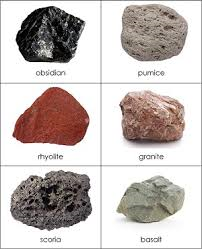Overview
Geologists classify rock into three different types; igneous, sedimentary, and metamorphic. These types of rocks differ by the way they form. Igneous rocks form from cooling magma. Sedimentary rocks are the result of compact sand and mud. Metamorphic rocks form from changes in either igneous or sedimentary rocks.
What Is Magma?
Magma is melted rock. It occurs naturally in the crust and in the upper mantle of the earth, in the asthenosphere. One of the reasons it is so difficult to drill holes deep into the crust is because the temperature rises about 30 degrees for every kilometer. The asthenosphere, between 100 and 350 km deep, is so hot that most of the rock is melted. It flows very slowly because it is under intense pressure. However, magma reaches temperatures between 600°- 1400° C, so even metals such as iron are easily melted. Some magma is expelled in volcanic vents and lava flows.
Formation and Types of Igneous Rocks
Melted magma is less dense than solid rock, so it tends to rise toward the surface. As it rises, it cools and solidifies when temperature and pressure drop. Shortly after the planet Earth was formed, the crust melted, so most of the crust still consists of types of igneous rock and metamorphosed igneous rock. Igneous rocks such as granite form when magma cools before it reaches the surface, while igneous rocks such as obsidian form when magma explodes in a volcanic eruption, then cools. Igneous rocks are classified by the minerals they contain, their texture, and their chemical composition. For example, granite contains flecks of quartz, feldspar, and amphibole. It is relatively coarse-grained, because the different types of mineral crystals are easily seen. It is a silicate, and also contains other elements such as aluminum, iron, and magnesium. By contrast, the igneous rock rhyolite is composed of similar minerals but it very fine-grained and smooth. Obsidian is a type of rhyolite. Basalt is dark, also fine-grained, and contains a higher percentage of iron and magnesium to silica than granite.
Sedimentary Rocks
Gravel, sand, and clay are cemented together by time and pressure to become sedimentary rock. The grains of sediment are bonded by materials that dissolve and precipitate. For example, red sandstone gets its color from dissolved iron oxide, while limestone contains white carbonates. The White Cliffs of Dover are made of chalk, a very fine-grained type of limestone.
Metamorphic Rocks
Metamorphic rocks are the result of changes to igneous or sedimentary rocks as a result of temperature or pressure. For example, limestone under great conditions of heat and pressure becomes marble. It has the same chemical and mineral structure as limestone, but has a different texture. Other types of metamorphic rocks change structure, such as shale to slate, schist, or gneiss.
Interested in science tutoring services? Learn more about how we are assisting thousands of students each academic year.
<span class=”tutorOrange”>SchoolTutoring Academy</span>is the premier educational services company for K-12 and college students. We offer tutoring programs for students in K-12, AP classes, and college. To learn more about how we help parents and students in Coralville, IA: visit Tutoring in Coralville, IA




